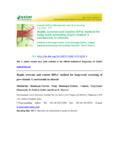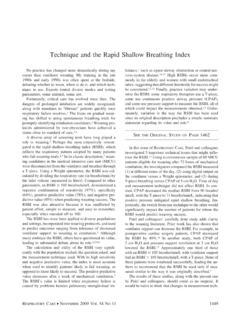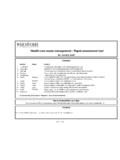Transcription of Rapid assessment tools - Food and Agriculture …
1 25. Rapid assessment tools Fire management professionals require reliable and accurate field-level information in order to plan and to be effective in their work. In addition to the information that they have from their technical backgrounds, training, and professional experiences, it is essential that they receive information about: the areas where they are working, the local conditions, the culture, and the social and economic circumstances of the people who are affected by their actions (FAO, 1996). For CBFiM to succeed, gaining a solid understanding of the community context is critical. There are a number of approaches that have been developed to enable the collection of information at the field level. Some examples of field-collection methods are described below, though it should be noted that the existing studies of CBFiM have not applied a common method and that there is no single accepted method.
2 PARTICIPATORY Rapid APPRAISAL. A well-known and widely used approach is Participatory Rapid Appraisal (PRA). PRA is a family of methods that enable individuals to share and assess their local knowledge, thereby allowing them to plan and to act (Chambers, 1994), with outsiders facilitating rather than controlling the process (World Bank, 1994). tools developed and used in this process facilitate the collection and analysis of information by and for community members, with an emphasis on local knowledge. PRA methods provide information to both outsiders who wish to understand how the community uses and manages its resources and to the communities themselves, enabling them to evaluate resource management practices. Both are valuable inputs to resource management and to CBFiM in particular.
3 The information collection process, if applied correctly, also provides a forum for informal and unbiased dialogues with the community members and with a variety of stakeholders, including representatives from local government divisions. This information-gathering through dialogue allows for an in-depth examination of existing practices, problems, conflicts, and opportunities regarding the use of resources, thus providing a basis for developing more sustainable and productive management systems (Asia Forest Network, 2002). RANKING, SCORING AND MATRICES. Matrices are used to assess the relative prioritization of the elements of a single issue, in this case fire use, by individual groups (Table 1). This technique can be used to identify constraints or opportunities as well as to explore preferences and to attempt to develop an understanding of the basis on which choices and decisions are made (Jones, 1995).
4 26 Community-based fire management - A review TABLE 1. A ranking and scoring matrix used in Participatory Rapid Appraisal Fire use Month used Value Comments (importance). Fire is now very intense and burns Rice paddy preparation January 1. very hot. Fire has become difficult to control Land clearing October 5. and to keep in designated areas. Fire used in the forest is a tool to Mushroom collection March 3. grow mushrooms. We are often not allowed to use Honey collection September 6 smoke to collect honey because of the danger from fire. Most medicinal plants do not like Traditional medicines November 4. fire. Fire is used to hunt for animals;. however, a lot of animals Hunting July 2. disappeared when the forest was cut down. Source: Johnson (2006).
5 ANALYSIS TABLES. Tables have been designed, theoretically and subject to preliminary trial, to gather information about fire that is related to the community quickly and effectively. The CBFiM Analytical Table (Table 2) is designed to capture information related to a particular group's or community's use of fire. The Fire Impacts Table (Table 3) is a more detailed perspective on the impact of fire and provides the opportunity to sort and describe those impacts. As part of an FAO North Asian regional training workshop on CBFiM in 2009, during a one-day field trip to a rural village in Yunnan province, participants conducted two-hour, semi-structured interviews with several different groups, including a women's group, an elders' group, a community leaders' group, a men's group and a group consisting of park staff.
6 The tables, and the information they contain, are provided as examples. TABLE 2. CBFiM analytical table (Data collected from Mangun village, Xishuangbanna prefecture). Types of fire being assessed within a community perspective 1 Prescribed fire (agricultural). 2 Wildfire Rapid assessment tools Point of origin Impact (+/ ) Ability to Intent to change Shared objectives change Insider Outsider Insider Outsider Rice paddy Neighbouring (+) minimizes harmful forest Where and Comply with policy Use of prescribed villages insects when to burn burning Sugar cane Adapt fire management fields Nature reserve (+) improves grazing for Policy practices to minimize Develop ways to livestock wild animals conflict with nature decrease accidental fire Grasslands Nature reserve No ability for reserve events (grazing) staff apply (+)
7 Controls grass minimizing community fire on reserve competition with seedlings to change Fire is the custom, is part Reduce fuel loads on Forested boundary reserve burning of the local culture and the boundary between hillsides where fuel (+) fertilizes agricultural fields practices is needed for Agriculture the reserve and the Celebrations loads are (+) reduces hazardous fuels community heavy and risk Classify the Fires to be lit after (festivals). of fire is high. (+) increases natural tree reason for a hours when fire danger Increase fertility of the regeneration prescribed burn is low soil ( ) potential of escaped fires Prepare burn The community does not Possible to create some into nature reserve plans intend to change reserve shared objectives in the burning practices that nature reserve buffer (+) stop large fires they perceive to be zone (+) improved wildlife habitat positive and beneficial to the community ( ) soil erosion (protect the community ( ) water quality from large fires).
8 ( ) wildlife loss May occur in November each year at the ( ) tree mortality prefecture permit stage Source: FAO (2009a). 27. 28 Community-based fire management - A review TABLE 3. Fire Impacts Table (Data collected from Mangun village, Xishuangbanna prefecture). Fire type 1 Prescribed fire (agricultural). 2 Wildfire Impacts Inside Outside Positive Negative Positive Negative Ecological Increased Destroys forest Regeneration of Destroys forest fertility of land pine and oaks Regeneration of Control pests (mice, pine and oaks etc.). Control pests (mice, etc.). Environmental Smoke/haze Smoke/haze Reduced water Reduced water quality quality Social Makes the Experience in community how to prevent happy agricultural fires burning into the Social harmony natural reserve Social harmony Safety Protects the Injuries/ Avoid fires Injuries/accidents community accidents escaping into the nature reserve Property forest damage Promote the skills of the nature reserve staff Health Smoke/haze Smoke/haze Reduced water quality Economics Increased Economic loss Economic loss agricultural (subsistence products Costs of and conducting livelihoods) Increased burns (labour, household fuel, etc.)
9 Incomes Increased NTFPs (mushrooms). Political Harmonious Harmonious society society Source: FAO (2009a).
















